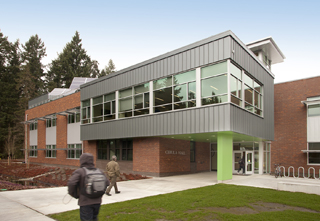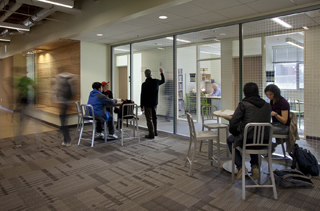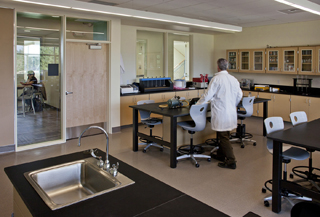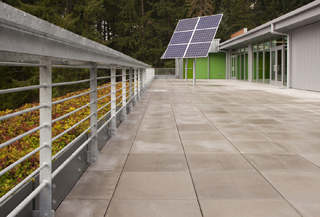|
Subscribe / Renew |
|
|
Contact Us |
|
| ► Subscribe to our Free Weekly Newsletter | |
| home | Welcome, sign in or click here to subscribe. | login |
Environment
| |
 |
February 28, 2013
Engineering school’s new home reflects its values
McGranahan Architects

Gleason
|
In 2006 the National Science Foundation brought together an international group of prominent engineers and scientists to establish a list of global challenges for the 21st century, addressing the areas of sustainability, health, joy of living and reducing vulnerability.
Many of these challenges incorporate some element of engineering, whether it’s finding ways to harvest energy resources, preserving and creating a sufficient amount of drinking water or making community infrastructure more effective for living, doing business and sharing ideas. In order to better prepare students to tackle these types of challenges, Saint Martin’s University in Lacey set out to construct a new engineering building. The project, called Cebula Hall, offered a unique opportunity to support a growing engineering program that hoped to contribute to the advancement of sustainability.
Following ideals
Saint Martin’s is a Benedictine university that is co-located with an abbey. The Benedictine community sets an example in how they live off their land and exhibit sound development standards that include progress and preservation. University leadership follows these same ideals and wanted their new building to reflect that ethic, including their values of faith, reason, service and community.
For decades the engineering program operated in a building that was originally used as a saw mill. Faculty, staff and students persevered and developed a strong program despite the facility’s limitations. In addition to the building’s physical challenges, it didn’t support the program’s desire for rigor and collaboration.
The new Cebula Hall reflects the university’s leadership in engineering and its interest in sustainability. Early in the design process, the project team set a goal of LEED platinum.
Modest cost
Design elements for the new Cebula Hall include on-site renewable energy of a 21.8-kilowatt photovoltaic array, ground-source heat, use of a regional stormwater facility, on-site potable water source, energy-efficient envelope, significant energy optimization and education innovations. As a result, the building:
• reduces potable water use by 48 percent;
• improves energy utilization by over 63 percent compared with the baseline university building;
• produces over 15 percent of its own power needs while providing the remainder through green power sources;
• utilized FSC-certified wood (78 percent) and materials with recycled content (27 percent); and
• diverted or recycled 96 percent of construction waste.
| Cebula Hall |
|
Height: Three stories Size: 26,900 square feet Budget: $7.4 million Completion: 2012 Owner: Saint Martin’s University Architect: McGranahan Architects General contractor: Berschauer Phillips Construction Structural engineer: PCS Structural Solutions Civil engineer: Shea Carr Jewel Landscape architect: Robert W. Drewel Landscape Architect Mechanical: Sunset Air Electrical: Taurus Electric |
The construction cost was $205 per square foot, dispelling the notion that LEED platinum buildings cost as much as 15 percent or more than similar non-sustainable buildings. University laboratory building construction costs can range between $275 to $400 per square foot, depending on project variables.
At 26,900 square feet, the compact three-story building absorbed the cost burden of laboratories, vertical circulation and a rooftop lab. Achieving high performance at such a modest cost is significant given the lack of economy of scale.
Life-cycle costs were considered for most elements and systems. The ground-source HVAC system has a five-year payback and made sense from a first and life-cycle cost position. The only long-term return on investment was the solar panel installation, which has an approximate 25-year payback.
Building a teaching tool
Creating a sustainable learning environment includes more than saving energy and using local materials. It should also provide opportunities to explore in an environment that makes studying, researching and discussing invigorating, effective and immersing.
The arrangement of spaces in the new engineering building focuses on relationships that encourage collaboration and educational cross-pollination as well as the functions within the individual spaces. Transparency, proximity and access to shared spaces are also key to the success.
Spaces inside and out were organized to capitalize on collaborative learning opportunities. Labs and classrooms are positioned directly across from a transparent faculty office suite that is outfitted with a glass writing surface to support both planned and impromptu study and research opportunities as well as visibility between spaces.
The building displays many engineered systems as a way of surrounding faculty and students with real world examples of their studies. Many of the building’s structural, civil and mechanical systems are displayed or “peeled back” to facilitate dialogue and support the school’s curriculum.
The upper floor of the building is carved away to provide access to a rooftop lab that houses demonstrative solar panels as well as additional lab project space visible to the campus. The roof lab includes two dual-axis solar panels that allow students to study the benefits of tracking devices, solar orientation and the production of solar energy.
This will be an area of research and study for the school, given the importance of affordable renewable energy sources and the influence that engineering will have on solving that challenge. The freestanding devices allow for easy retrofitting of future solar panel technologies.
One of the unique labs in the building is designed for education as well as supporting research. The thermal engineering program has previously garnered support from NASA to build and test a heat flux simulator. In support of programs such as this, the new space was designed to precisely control the interior environment and provide flexible layout. Generous access to utilities supports the innovative constructs created for research in thermal dynamics and mechanical systems.
A small footprint
Cebula Hall’s footprint, placement and orientation support the project’s sustainability goals. The small building footprint replaced existing tennis courts; reducing the site’s overall impervious surface.
A rain garden at the front of the building allows easy access for civil engineering classes to study the merits and means of achieving stormwater quality. Learning and furthering ideas is heightened when interaction is supported and encouraged by strategic placement of spaces and features.
The building was positioned to create a new campus quadrangle, providing a place for students to hang out, socialize and study. The quad was developed along with the project and supports the horizontally oriented ground loop array that supplies heating and cooling to the building’s HVAC system.
From the quad students can observe a unique building that displays activities and research on the roof lab, strengthening the exposure of the School of Engineering’s community activities to the rest of campus.
To keep energy and environmental issues relevant, each new generation must remain engaged. Progress in sustainable engineering and design will be influenced as much by the ingenuity of people and the inspiration of spaces provided to them for study and research as it will through new methods or technologies.
With this new building, Saint Martin’s University has set an example of sustainable development while providing a healthy, high-performing and attractive environment that supports education in the engineering disciplines that may one day solve some of the world’s greatest engineering challenges.
Marc Gleason is principal for design for McGranahan Architects, a 29-person architectural and interior design firm located in Tacoma.
Other Stories:
- Don’t let green-minded clients leave you behind
- New transfer station lifts Makahs out of the dumps
- Falling costs could mean a bright future for solar panels
- Is LEED’s future with federal projects under threat?
- A crucial step that green building teams often skip
- Thermal ‘ravioli’ keeps building temps in check
- Bullitt neighbor seeks a green distinction of its own
- How contractors can make the supply chain greener
- What to look for in a green building






